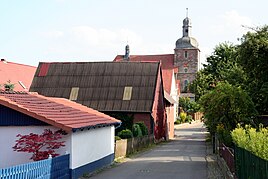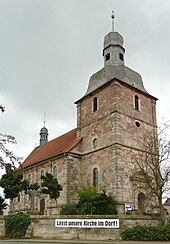Desingerode
|
Desingerode
City of Duderstadt
|
||
|---|---|---|
| Coordinates: 51 ° 31 ′ 33 " N , 10 ° 10 ′ 54" E | ||
| Height : | 199 m above sea level NN | |
| Residents : | 548 (Nov. 1, 2019) | |
| Incorporation : | 1st January 1973 | |
| Postal code : | 37115 | |
| Area code : | 05527 | |
|
Location of Desingerode in Lower Saxony |
||
Desingerode is a place in the district of Göttingen in Lower Saxony and is located on the district road 105 between Esplingerode and Werxhausen , six kilometers northwest of Duderstadt in the middle of the Golden Mark . The village, which belongs to the Untereichsfeld , has been a district of the city of Duderstadt since January 1, 1973 , forms a locality with Esplingerode and Werxhausen and has around 520 inhabitants.
geography
Desingerode is located at the foot of the Seulinger Forest and has a district of 5.64 km². This area is traversed by the two rivers Hörgraben and Hörfloth. The highest point in the area is the Fuchsberg in the Desingerode forest (height: 280 meters). On the Fuchsberg there is a barrow field with more than 60 grave sites. In the meantime, traces of the much older time of the linear ceramic culture have been found in the fields of the village.
history
The burial mound on the Fuchsberg shows that people lived in the Desingerode district as early as the Bronze Age . At the beginning of the 1990s, fragments from even earlier times were found in the Desingeröder corridor. However, these people were nomads, so that one cannot say the place Desingerode is already as old as these finds, which are over 4000 years old. On July 26, 952, the place was mentioned in writing for the first time in a document from Otto I , in which he exchanged goods with the Saxon Landgrave Hermann Billung under the name "Dasingerod". In the following year Otto donated the village to the newly founded Mauritian monastery in Magdeburg. The village was one of the five Kespeldörfern in the city of Duderstadt, which the Elector Albrecht of Mainz placed under the jurisdiction of the Gieboldehausen Office in 1525 . In the Thirty Years' War also Desingerode was burned in 1646 were of 37 yards or hearths only referred to as another 14 inhabited. The main landlords and owners of the church patronage in Desingerode were the lords of Desingerode and, after their extinction, the lords of Uslar-Gleichen .
The more or less legendary founding of the place was done by a knight named Daso, whose people the Dasinge cleared the forest and built the first house in the village, a castle, at this point. The name of the village was then formed from Daso, Dasinge and clearing, as it is handed down in the document of the year 952. Dasingerod. The name of the Burgstrasse and the entire village quarter "auf der Burg" still reminds of that place.
At the end of World War II, on April 9, 1945, the village was shelled by American troops. A mother and two of her children were killed. Three people were injured. In 1952 the village anniversary "1000 years of Desingerode" was celebrated. Until 1973 the village was an independent political municipality. In 2002 the 1050th anniversary of the first documentary mention was celebrated with a festival week.
Parish
Desingerode has been a parish with the Esplingerode branches and at times also Werxhausen since at least 1207 . In 1230 a first pastor and a church of the place are mentioned. Since then, 41 priests of the place are known by name. The current church of Saint Mauritius and Companions is the fourth known church in the area and was built from 1749 to 1754 under the direction of Pastor Johann Christian Krebs (born August 15, 1707 in Seulingen , † September 28, 1782 in Desingerode). Master builders were the council carpenter Henricus Petersen and the Italian Henrico Gelli . The church was consecrated on July 14, 1756 by the Mainz auxiliary bishop in Erfurt, Johann Friedrich von Lasser . It is richly decorated in baroque style.
From 1884 to 1910 the priest and bell expert Carl Otto (born in Duderstadt) was pastor of St. Mauritius. Carl Otto and his brother Franz founded the Otto bell foundry in Hemelingen near Bremen in 1873/74, which cast bronze bells for the Mauritius Church in 1895, 1897 and 1962/3.
Since 1983 Desingerode has been part of a pastoral care unit with Esplingerode and Seulingen. In 2006 the anniversary of the consecration was celebrated with a festival week. In 2007 the jubilee "800 years Parish Desingerode" was celebrated.
Since November 1, 2014, St. Mauritius has belonged to the parish of St. Georg in Nesselröden as a branch church , the Desingerode parish was dissolved in this context.
The Desingerode church has been classified in category C 1 by the diocese of Hildesheim. This means that from 2014 the church building will no longer receive subsidies from the diocese. This capping of funds makes it very difficult for the small branch congregation to maintain the church or, in the opinion of many, made impossible. A decline of the church is feared.
The Desingeröder "billy goats"
The design bait is nicknamed "billy goats" in Eichsfeld . This nickname did not come about at some point due to a peculiarity of the design bait, but has a real historical background. At the end of the 17th century there were repeated disputes between Desingerödern and Westerödern over the ownership of arable land. Some of the land was no longer used because it was not possible to determine whether it was Desingeröder or Westeröder Land.
In 1695, the angry Desingeröder pulled the Westerödern into the field to finally clear things up. However, a billy goat was the only thing they captured. From this story, the Westeröder made a composed song that had 21 stanzas. In the song, the design bait is mocked for the trapped billy goat. The text of the song was even printed and sold on the market in Duderstadt.
The designers did not accept that and sued the authors of the poem. Indeed, the poet was punished with a fine of 10 Reichstalers or eight days in prison.
The story can be read in the Duderstädter city archive or in the chronicle of Desingerode.
politics
Since 1973 Desingerode has formed a joint local council with Esplingerode and Werxhausen. The local mayor is currently from Desingerode, and there is a deputy mayor each from Esplingerode and Werxhausen.
Local council
The local council consists of 13 councilors.
The local mayor is Dennis von Ahlen (CDU).
coat of arms
The coat of arms was approved by the state of Lower Saxony on December 9, 1950.
The rose in the coat of arms is taken from the seal of Johann von Desingerode from 1308.
Infrastructure
After the bypass road for Esplingerode has been built, Desingerode can be reached even more easily by car via federal road 446 . The place is connected to the bus network via line 150 of the Braunschweig regional bus. The place itself is approached by 60% of the lines. The place is fully connected via the stop "Desingerode Abzweigung".
When the primary school in Desingerode was closed in 1972, a kindergarten was set up in the building, which up to 50 children can attend. The kindergarten is sponsored by the city of Duderstadt.
In 1979 a parish hall was built with the support of the Hildesheim diocese. The house serves as a meeting and event center. Private parties are also held there. The large hall of the house seats about 90 people.
Associations and associations
- Desingerode fire department, founded in 1953
- Sports club DJK Desingerode since 1921
- Catholic women's community Desingerode / Esplingerode (founded on June 16, 1912 by the local pastor at the time)
- Kolping family Desingerode
- Desingeröder Carnevallub (DCC) founded in 1981
- Kyffhäuser Kameradschaft Desingerode, founded in 1881
Web links
Individual evidence
- ↑ Population statistics as of November 1, 2019 City of Duderstadt, accessed on May 7, 2020.
- ^ Federal Statistical Office (ed.): Historical municipality directory for the Federal Republic of Germany. Name, border and key number changes in municipalities, counties and administrative districts from May 27, 1970 to December 31, 1982 . W. Kohlhammer GmbH, Stuttgart and Mainz 1983, ISBN 3-17-003263-1 , p. 206 .
- ↑ a b Lufen, Peter Ferdinand: Monument topography Federal Republic of Germany. Architectural monuments in Lower Saxony , vol. 5.3: Göttingen district, part 2 . Altkreis Duderstadt with the communities Friedland and Gleichen and the combined communities Gieboldehausen and Radolfshausen. Published by the Lower Saxony State Administration Office - Institute for Monument Preservation -. CW Niemeyer, Hameln 1997, ISBN 3-8271-8257-3 , pp. 189ff.
- ^ Gerhard Reinhold: Otto bells. Family and company history of the Otto bell foundry dynasty . Self-published, Essen 2019, ISBN 978-3-00-063109-2 , p. 588 , here in particular pp. 20, 29, 33, 53, 75, 122, 123, 250, 258, 405, 507, 572 .
- ↑ Gerhard Reinhold: Church bells - Christian world cultural heritage, illustrated using the example of the bell founder Otto, Hemelingen / Bremen . Nijmegen / NL 2019, p. 556 , here in particular pp. 48, 50, 56, 92, 93, 136, 137, 232, 239, 240, 376, 474, 475, 513, 526 , urn : nbn: nl: ui: 22-2066 / 204770 (Dissertation at the Radboud Universiteit Nijmegen).
- ↑ a b Result of the local council election Des./Espl./Werxh. 2016 on 09/11/2016 - City of Duderstadt / Des./Espl./Werxh. Municipal Services Göttingen, accessed on September 18, 2018.
- ↑ Dennis von Ahlen (CDU) is the local mayor of Desingerode on the website of the Göttinger Tageblatt, accessed on January 24, 2014.



